
The Northern City Line is a commuter railway line in England, which runs from Moorgate station to Finsbury Park in London with services running beyond. It is part of the Great Northern Route services, and operates as the south-eastern branch of the East Coast Main Line (ECML). It is underground from Moorgate to Drayton Park in Highbury, from which point it runs in a cutting until joining the ECML south of Finsbury Park. Its stations span northern inner districts of Greater London southwards to the City of London, the UK's main financial centre. Since December 2015, its service timetable has been extended to run into the late evenings and at weekends, meeting a new franchise commitment for a minimum of six trains per hour until 23:59 on weekdays and four trains per hour at weekends.
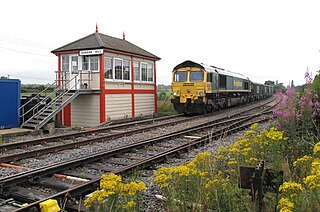
On a rail transport system, signalling control is the process by which control is exercised over train movements by way of railway signals and block systems to ensure that trains operate safely, over the correct route and to the proper timetable. Signalling control was originally exercised via a decentralised network of control points that were known by a variety of names including signal box, interlocking tower and signal cabin. Currently these decentralised systems are being consolidated into wide scale signalling centres or dispatch offices. Whatever the form, signalling control provides an interface between the human signal operator and the lineside signalling equipment. The technical apparatus used to control switches (points), signals and block systems is called interlocking.

Railway signalling (BE), also called railroad signaling (AE), is a system used to control the movement of railway traffic. Trains move on fixed rails, making them uniquely susceptible to collision. This susceptibility is exacerbated by the enormous weight and inertia of a train, which makes it difficult to quickly stop when encountering an obstacle. In the UK, the Regulation of Railways Act 1889 introduced a series of requirements on matters such as the implementation of interlocked block signalling and other safety measures as a direct result of the Armagh rail disaster in that year.

A loading gauge is a diagram or physical structure that defines the maximum height and width dimensions in railway vehicles and their loads. Their purpose is to ensure that rail vehicles can pass safely through tunnels and under bridges, and keep clear of platforms, trackside buildings and structures. Classification systems vary between different countries, and gauges may vary across a network, even if the track gauge is uniform.
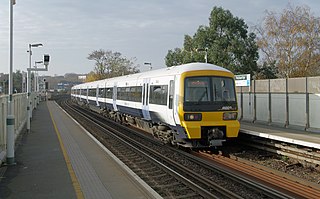
The Catford Loop Line is a railway line in southeast London. It carries a suburban stopping passenger service from central London to Sevenoaks, and is also a relief route for the Chatham Main Line carrying passenger trains from London Victoria to the Kent coast. There is also much freight activity as this is the main route to Willesden and the north via Latchmere Junction. Freight traffic includes aggregates trains to and from locations along the Thames estuary, and Kent, aviation fuel running between Colnbrook and the Isle of Grain, and a small number of international workings from the Channel Tunnel via the yard at Dollands Moor. Until around 2013, a significant quantity of intermodal traffic from Thamesport used the line - however, the opening of London Gateway meant that the larger container ships stopped serving Thamesport and this traffic then ceased.
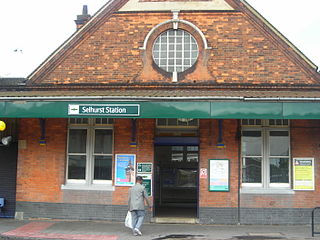
Selhurst railway station is in the London Borough of Croydon in south London, 9 miles 31 chains (15.1 km) along the line from London Victoria. It is operated by Southern, which also provides all the train services. The station is in Travelcard Zone 4.

The Abbey Line, also called the St Albans Abbey branch line, is a railway line from Watford Junction to St Albans Abbey. The 6.5-mile (10.5 km) route passes through town and countryside in the county of Hertfordshire, just outside the boundaries of the Oyster Card and London fare zones. Its northern terminus in St Albans Abbey is located in the south of the city, around 1.2 kilometres (0.75 mi) away from the larger St Albans City railway station on the Midland Main Line.

The Sutton and Mole Valley lines were constructed between 1847 and 1868 by the London, Brighton and South Coast Railway, the London and South Western Railway and the LBSCR-sponsored Horsham, Dorking and Leatherhead Railway.

The Fen Line is a railway line in the east of England that links Cambridge in the south to King's Lynn in the north. The line runs through Cambridgeshire and Norfolk and the name of the line refers to the Fens which border Cambridgeshire, Norfolk and Lincolnshire. It is 41 miles 47 chains (66.9 km) in length and has eight stations.

The Hertford loop line is a branch of the East Coast Main Line, part of the Northern City Line commuter route to London for Hertford and other Hertfordshire towns and an occasional diversion route for the main line. The line is part of the Network Rail Strategic Route 8, SRS 08.03 and is classified as a London and South East Commuter line.

The railway signalling system used across the majority of the United Kingdom rail network uses lineside signals to control the movement and speed of trains.

The Great Northern route is the name given to suburban rail services run on the southern end of Britain's East Coast Main Line and its associated branches. Services operate to or from London King's Cross and London Moorgate in London. Destinations include Hertford North, Welwyn Garden City, Stevenage, and Cambridge, and in peak hours, additional services run to Peterborough and King's Lynn. Services run through parts of Greater London, Hertfordshire, Bedfordshire, Cambridgeshire, and Norfolk.

Slippery rail, or low railhead adhesion, is a condition of railways (railroads) where contamination of the railhead reduces the traction between the wheel and the rail. This can lead to wheelslip when the train is taking power, and wheelslide when the train is braking. One common cause of contamination is fallen leaves that adhere to the railhead of railway tracks. The condition results in significant reduction in friction between train wheels and rails, and in extreme cases can render the track temporarily unusable. In Britain, the situation is colloquially referred to as "leaves on the line".
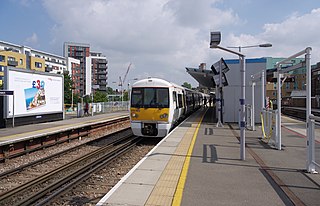
The Greenwich line is a short railway line in South London that follows part of the route of the London and Greenwich Railway, which was the first railway line in London.

A public transport timetable is a document setting out information on public transport service times, to assist passengers with planning a trip. Typically, the timetable will list the times when a service is scheduled to arrive at and depart from specified locations. It may show all movements at a particular location or all movements on a particular route or for a particular stop. Traditionally this information was provided in printed form, for example as a leaflet or poster. It is now also often available in a variety of electronic formats.
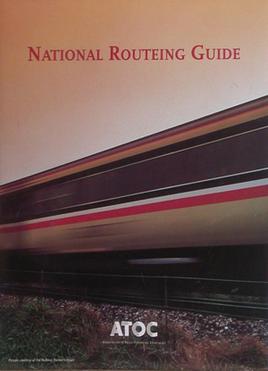
The railway network of Great Britain is operated with the aid of a number of documents, which have been sometimes termed "technical manuals", because they are more detailed than the pocket-timetables which the public encounters every day. Historically, they were classified PRIVATE and not for publication, however since rail privatisation they are now more widely available, mostly in digital form, because they are produced centrally and not by the regional rail operators.
A working timetable (WTT) - - The data defining all planned train and rolling-stock movements which will take place on the relevant infrastructure during the period for which it is in force; within the EU, it is established once per calendar year. The trains included may be passenger trains, freight trains, empty stock movements, or even bus and/or ship connections or replacements.

The Hitchin Flyover is a grade-separated single-track railway viaduct near Hitchin, Hertfordshire, England, which carries the Down Cambridge Flyover line over the East Coast Main Line. Constructed between 2012 and 2013, it connects the westernmost track of the East Coast Main Line with the Cambridge line. The flyover was built to increase the throughput at Cambridge Junction, a congested flat junction, which put severe constraints on capacity on both lines.

Cranbrook railway station serves the new town of Cranbrook near Exeter in Devon, England. The station is on the West of England Main Line between Whimple and Pinhoe stations, 166 miles 15 chains (267.5 km) down the line from London Waterloo. It is the newest station on the line, having opened in December 2015.
Route knowledge is one of the core skills together with train handling and a full understanding of railway rules, which the operating crew must possess in order to be able to operate a train safely.

















